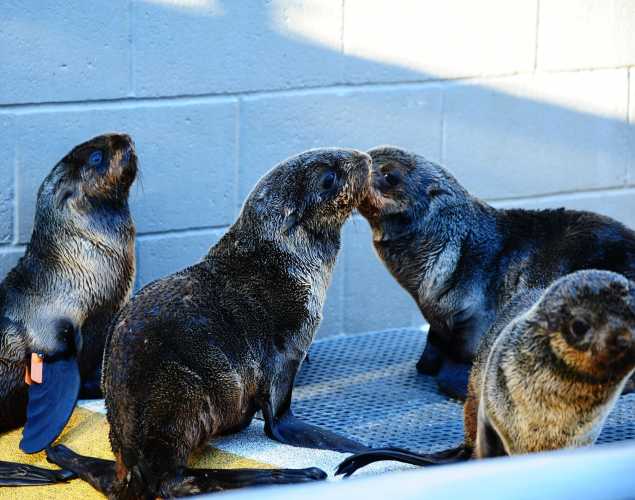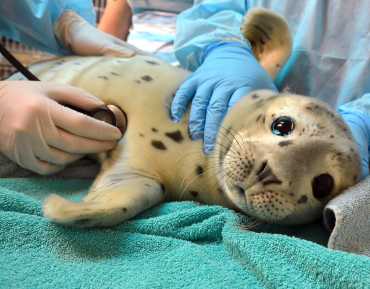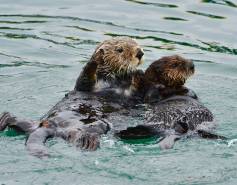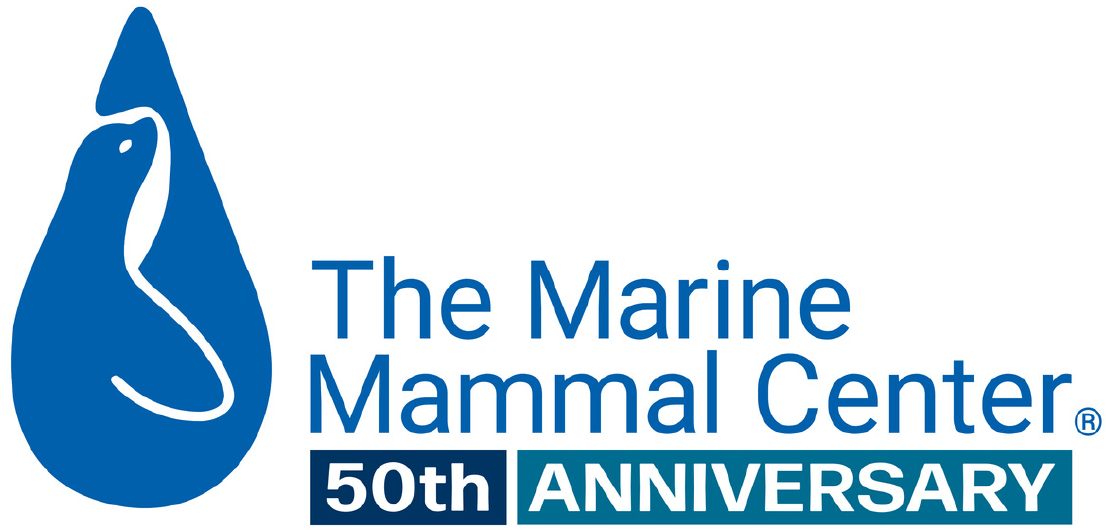
Unusual Ocean Conditions Continue to Cause Record Strandings
- Malnutrition
Northern fur seals are the latest marine mammal species to fall victim to abnormally warm ocean waters and a lack of food sources.
Like the California sea lions and Guadalupe fur seals before them, these young, starving pups are stranding in record numbers.
2015 has been a year like no other for The Marine Mammal Center—with six weeks still remaining, we’ve already rescued more seals and sea lions than ever before in our 40-year history.
Breaking a Record Number of Records
By February, we had rescued a record number of California sea lion pups—all younger and skinnier than we typically see. Many of these pups had been weaned way too early to survive on their own.
By April, our busy elephant seal and harbor seal pup seasons were in full swing as well, and we were caring for a record number of patients onsite at our hospital in Sausalito, California: 291. In fact, we cared for more than 200 patients at a time for three solid months.
By June, we had rescued more than two dozen Guadalupe fur seals, five times our record yearly rate—a distressing statistic given this animal’s population status as a threatened species. By October, we thought we were done breaking records when we admitted our 1,632nd patient, breaking the all-time high set in 2009.
But within days, we had rescued Zachary, the first of what would become many northern fur seal pups stranding on our shores. So far, we have rescued more than 80 northern fur seal pups—three times the number we cared for last year and more than twice our previous record in 2006.
“Northern fur seals are smaller, furrier and feistier than the California sea lion pups we rescued earlier this year,” says Dr. Shawn Johnson, Director of Veterinary Science at The Marine Mammal Center. “But otherwise the scene here is the same—our rescue trucks continue to arrive day after day with more starving pups in need of our care.”
Our rescue trucks continue to arrive day after day with more starving pups in need of our care.
The greatest threats to marine mammals are caused by people, but we can also be their greatest champions.
Sign up for email from The Marine Mammal Center to stay updated on how you can be an advocate and champion for marine mammals like northern fur seals.
Why Is This Happening?
All told, we have rescued more than 1,747 seals and sea lions so far this year—breaking nearly every record in our 40-year history and, more importantly, raising alarming questions about the health of our ocean.
Most of those questions surround the climatological phenomena dubbed “the blob,” an unusually large and persistent area of warm water that originated in the Gulf of Alaska and at times extended all the way down the Pacific coast to Mexico. Other factors likely also contributed to the unusually warm waters we’ve seen in this area since 2013.
What’s happening off the California coast is caused not by any one environmental condition but rather a perfect storm: Unusually weak winds from the north and strong winds from the south are causing a change in currents and a lack of upwelling that would typically bring colder water and nutrients to the surface, which can increase fish abundance.
These warmer waters, which some scientists also link to global climate change, seem to be affecting distributions of fish, causing marine mammals like sea lions and fur seals to have a harder time finding food close to their typical habitat range.
And with an unusually strong El Niño taking shape in the equatorial Pacific, conditions are not likely to change much any time soon. The warm waters El Niño is expected to bring will simply reinforce or extend the dramatic effects we’ve seen to date.
At stake are sensitive populations of marine mammals, such as the Guadalupe fur seal, as well as otherwise healthy populations, like the California sea lions, which have sustained their third year of elevated strandings—each worse than the year before.
Examining the Bigger Picture
While our dedicated animal care volunteers are working long hours to ensure every one of our 80+ northern fur seal pups gets a second chance just like Zachary, our scientists are looking closely at what’s happening to these animals and our ocean environment on a larger scale.
“What’s especially concerning about this current northern fur seal crisis is that this species has a particularly difficult time recovering from unfavorable ocean conditions, such as these warmer waters,” says Tenaya Norris, marine scientist at The Marine Mammal Center.
What’s especially concerning about this current northern fur seal crisis is that this species has a particularly difficult time recovering from unfavorable ocean conditions, such as these warmer waters.
Many of the same questions that plagued us during the height of the sea lion crisis earlier this year still remain. While experts are able to explain how this is happening—unusually warm waters are affecting food availability for mothers and pups—they still can’t explain exactly why.
No one was able to predict that this massive warm water blob would form and persist for the last year, so no one can predict when it will dissipate, allowing the ecosystem to rebalance itself. And with El Niño potentially contributing to the warm waters as well, the future becomes even murkier.
What we do know is that the record numbers of stranded marine mammals we’ve seen all year indicate there is an urgent need for more science to help us all better understand what’s going on off the coast of California and how large-scale human impacts, such as overfishing and pollution, may be affecting the health of these animals and their ocean environment as well.
“Northern fur seals are just the latest victims of the warm waters off of our coast,” Dr. Johnson says. “And as these conditions persist, we’re increasingly concerned about what this could mean for the next generation of sea lion pups too.”
Yes, I want to save a life!

Yes, I want to save a life!
You’ll be giving sick and injured animals the best possible care at the Center’s state-of-the-art hospital. With your gift today, you are giving a patient a second chance at life in the wild.
See Our Latest News
{"image":"\/Animals\/Wild\/Sea otter\/so-wild-morro-bayphoto-c-brian-simuro-20.jpeg","alt":"Sea otter and pup","title":"Watch a sea otter pup reunite with its mother","link_url":"https:\/\/www.marinemammalcenter.org\/news\/watch-sea-otter-pup-reunite-with-its-mother","label":"News Update","date":"2025-11-14 10:35:41"}

{"image":"\/Animals\/Wild\/Sea otter\/sea-otter-photo-c-brian-simuro.jpeg","alt":"Sea otter","title":"AP News: Baby sea otter is reunited with mother in central California after dramatic rescue","link_url":"https:\/\/www.marinemammalcenter.org\/news\/ap-news-baby-sea-otter-is-reunited-with-mother-in-central-california-after-dramatic-rescue","label":"In the News","date":"2025-11-14 09:46:34"}

AP News: Baby sea otter is reunited with mother in central California after dramatic rescue
November 14, 2025
Read More{"image":"\/Animals\/Patients\/Harbor seals\/2013\/cropped-images\/hs-bogey-by-ingrid-overgard-c-the-marine-mammal-center-371-0-2712-2118-1607385758.jpg","alt":"harbor seal Bogey","title":"Top Holiday Gifts for Ocean Lovers","link_url":"https:\/\/www.marinemammalcenter.org\/news\/top-eco-friendly-holiday-gifts-that-give-back","label":"News Update","date":"2025-11-04 01:00:00"}

{"image":"\/Animals\/Wild\/Hawaiian monk seal\/cropped-images\/hms-wild-photo-1-c-noaa-pifsc-hmsrp-35-0-1270-992-1759760452.jpg","alt":"A Hawaiian monk seal rests on its side on a sandy beach.","title":"Where Do Hawaiian Monk Seals Live? And Other \u2018\u012alio Holo I Ka Uaua Trivia","link_url":"https:\/\/www.marinemammalcenter.org\/news\/where-do-hawaiian-monk-seals-live-and-other-ilio-holo-i-ka-uaua-trivia","label":"News Update","date":"2025-10-06 00:00:00"}

Where Do Hawaiian Monk Seals Live? And Other ‘Īlio Holo I Ka Uaua Trivia
October 6, 2025
Read MoreNorthern Fur Seal


